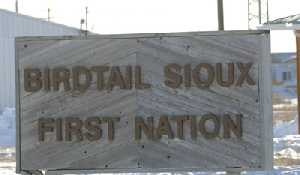Massive rainfall floods Saskatchewan and Manitoba
July 5, 2017, 3:04 am
Julia Dima


A rainfall warning was issued for the southeastern corner of Saskatchewan for the June 28 weekend—but nobody could have predicted how bad it would get.
Between around noon on Saturday, June 28 and Monday, June 30 when the rain began to recede, the southern corner of Saskatchewan and Manitoba was drenched—the hardest hit area was around Moosomin, where 200 mm of rain fell over the course of the weekend.
The result was massive floods that drowned crops, overloaded sewage and drainage systems, washed out countless grid roads, and even a number of major highways including the Trans-Canada Highway near Wolseley.
As of press time, 96 communities in Saskatchewan and Manitoba declared a state of emergency—as water flows east into Manitoba, that number could rise.
Some communities were dealing primarily with overland flooding, but in other communities like Moosomin, the excess water overwhelmed the sewage system, pushing raw sewage into people’s basements. Reports of flooded basements in Moosomin, Rocanville, and Maryfield ranged from one to six feet of water.
“I’ve never seen anything like this,” says Moosomin Mayor Larry Tomlinson. “I don’t remember this kind of damage before.”
In Moosomin, the town estimates that 30 to 50 per cent of households have been affected by flooding, mostly in the form of sewer back up, as both the storm and domestic sewer systems hit capacity on Saturday night. However an intersection on the west side of town at Windover Ave and Cook Road was covered by a few feet of water, and households in the area were fighting against seepage from the saturated ground surrounding their homes.
On the other side of town, a number of households lost power during the storm as heavy winds pummeled the town and uprooted trees.
Crystal Leshchyshyn lives on Carlton Street, and were it not for a neighbour’s concern, her home would have been catastrophically flooded.
“It started at 3 a.m. on Sunday morning with a neighbour, Barb Neufeld calling everyone to warn them. Had she not done that, we would have awoken with more problems. And for them, their basement was flooding, and they had way more water, but still took the time to notify everyone else,” Leshchyshyn says.
Leshchyshyn says she was lucky to only end up with about five inches of sewage in her basement—some of the homes on the street were pumping two to four feet of water, and when the power went out for about two hours, anyone who could not access a generator for sump pumps could do nothing about the escalating sewage filling their homes.
Town crews were out non-stop over the weekend trying to pump out the domestic sewer system and relieve households. Town Administrator Paul Listrom says that town crews barely slept over the weekend, and are still working to drain the flooded Cook Road area of town.
“It’s been a hectic week,” Listrom says with a sigh.
While Moosomin had the most recorded rainfall, the situation was not better elsewhere.
Ashley Foulds lives in Maryfield, and while she fared well, not having a basement in her home, every neighbour around her was dealing with sewage back-up, and the fire department spent all of Saturday night pumping storm drains.
Foulds says that she estimates all but two homes in Maryfield were dealing with flooded basements.
The biggest concern was that both Highway 48 an Highway 8 in both directions were closed down because of impassable wash-outs. Aside from a few precarious grid roads and back roads, there was no quick way in or out of town.
“There are a lot of elderly people, so if they needed emergency services, it would be very hard to get to a hospital—there are a lot of back roads but even some of those had a lot of water running over them,” Foulds says.
Foulds says water has receded around Maryfield, but the recovery process is going to be long because of the huge amount of people affected.
In Fairlight, Mayor Barry Metz says the village fared better than expected. There was flooding and some sewer issues, but no major damage, he says.
“South of us was worse, but we fared much better than I thought,” Metz says. The village of Fairlight is one of the few communities in the region who did not declare a state of emergency during the flooding.
“There was nothing that bad. Our basement flooding wasn’t to the extent of what other places were seeing—we got some wet floors, but we usually get this in the spring anyway. I am just happy everything came and went and now we are able to just clean up. The water is going to go down, and we are going to be back to normal.”
He added that the farmland was hit much harder than the town.
“Fields are a mess, pastures are a mess, it’s going to be a bad impact for quite a while for farmers.”
There were some concerns in the R.M. of Rocanville when the Welwyn dam came within a few feet of losing the spillway, but by Wednesday, the dam was down to a normal level.
However, the R.M. was dealing with a number of washed out and damaged roads.
“There are some major washouts, so right now, we are working on the litle ones that are quick to repair first, and then we start on the big ones. We have some major culverts washed out, and repair times are dependant on when we can get those pipes replaced—every R.M. is ordering culverts right now—so I am hoping we can get all the roads fixed within six weeks,” says R.M. Reeve Murray Reid.
Anyone who was trapped on their farmland by a washed out road was dealt with first, and according to Reid is now taken care of. Reid says that two families living on the South bank of the Qu’Appelle River may still be at risk as the river rises, but there has not been any risk yet that would cause them to evacuate.
In Rocanville, sewage damage was prevented because of the bypassing of the sewage lift station, which would have flooded otherwise. Nonetheless, about 200 households in town are dealing with flooding.
In Manitoba, the flooding is escalating as water flowing from the west is increasing water levels.
The R.M. of Ellice is dealing with a number of washed out roads, and around St. Lazare in the Assiniboine Valley, farmers” fields look more like lakes, according to administrator Rick Fouillard.
“It didn’t look good to start with because it was a wet spring and so a lot of farmers were just becoming able to seed.“
In St. Lazare, Fouillard says that households were dealing with flooded basements, so both the town and the village declared a state of emergency, since insurance will not cover seepage.
There is some concern that water levels in the Qu’Appelle River may rise.
“I was hoping things were starting to get back to normal, but the highways people told me there’s a whole bunch of water coming down the valley,” Fouillard says. He was told that the water level is supposed to come up a few feet, but there is three culverts in a spur line that slows down water in the valley. Last week, the water rose about six inches, but Fouillard says they are still watching to ensure people along the valley remain safe.
As for farmland, there is no doubt that there will be large crop losses this year.
Jeff Vanrobaeys at Parrish and Heimbecker in Moosomin says that many seeded acres will be lost. Because of a very wet spring, there are many late-seeded crops, and they are the crops struggling with the water. High humidity and moisture are creating risk for leaf diseases for the crops that survive. Overland water movement has also washed out plants, causing more problems than the typical standing water after a bad rain. Vanrobaeys estimates that there’s been about a 15 to 25 per cent loss of crops in the region—but that could rise, as moisture stress appears to be more evident each day.
Kevin Woods of Westwood Land and Cattle says he’s not sure what his losses are yet, since the fields are too saturated to get out on—he says that access to the fields to diagnose the damage is a big concern since there are many washed out roads. Woods says this is worse than 2011 because back then, seeding couldn’t get done.
“We’ve never seen water like we have now. In 2011, we never got to seed, but this year we did get started, and then we were plagued by wetness all along, and when you throw this on top, it just puts the icing on the cake—it’s bad, there’s no doubt about that,” he says.
In the Maryfield area, farmer Kristjan Hebert says it’s not as bad as he was expecting.
“I would say that we are only 10 per cent underwater, and the uncovered sections—if the sun sticks around—I think could recover,” he says.
Craig Roy farms near Moosomin, and he’s estimating a 20 to 25 per cent loss.
“It’s just going to be one of those years where we’re spinning our wheels, and just trying to break even—we need to have a very profitable crop to break even with the losses,” Roy says.
The flooding has brought major damages with it, but it has also brought out the community spirit of helping you neighbour.
It was such great neighbourhood spirit,” says Leshchyshyn. Aside from her neighbour first alerting her to the flood situation in Moosomin, all neighbours in the community were lending a hand, or sharing hoses, generators and pumps.
“That was how it was all day, everyone going from house to house asking people if they are okay, if they need food or any help. It was wonderful to see—it’s why we love the neighbourhood we live in. Everyone pulled together,” she says.
Summer Heide lives on a farm outside of Moosomin, and she put together a Facebook page called “2014 Flood Help” to bring together people in the region in need of help with those who could help. The group, which she started on Sunday morning, had already accumulated around 3,000 members by the end of the weekend.
Heide says that—trapped on her farm because the only road out was engulfed in water—she felt she had to do something to help those she saw in trouble.
“I felt helpless because I couldn’t get to town to help. So many of my friends were posting on Facebook that they needed shop vacs, and stuff like that, and I couldn’t get to town, so I just thought it would be a good way to get people connected outside of their friend circles, that they might be able to find help.”
The group was being used to offer help, to step up to the plate when someone indicated a need, to share pictures and videos of differently affected areas, and many people were even offering their homes and food to anyone left without services.
Heide says it was inspiring to see the small town spirit of community stretching to so many individuals.
“When you’re from a small town, you can just count on it that you are all there for each other. The group shows that. It’s nice to see the community coming together when people need each other.”
Having that massive network of communication ended up being very important to Ida Keightley, who lives just outside of Moosomin when she needed to rescue her two horses from rising waters on her land.
“Towards the end of the first day, the water started to rise. You could literally see the water rising. In the early hours of Sunday morning, I was out at about 4:30, and I could see my horses were beginning to panic. I went outside and could see how far the water had come up, and I said, that was it, we are going to have to get the horses moved. We had to go into town, and by the time we got back from town, where I’d stood before, it was too deep to stand. And then it was the sheer panic that I had to get them out. When we got them out, there was about a foot of water where they had been standing, and that rose another foot after we got them out. They would have been above their knees in water,” Keightley explains.
Valley View stables was able to offer Keightley space for her horses to board until the water levels fell, but because she had put a message on the flood help page set up by Heide, Keightley says she was overwhelmed with e-mails and calls from people offering to take in her horses.
“I had people from Swift Current, Regina, Rocanville—everywhere offering to take my horses in. You can feel like you are all alone in this situation, but with the Facebook page set up, you see you’re not. If many of us didn’t have that, we would have been all alone,” Keightley says.
In Maryfield, Foulds says everyone was out caring for their neighbours.
“Everybody around here has been helping everyone—people knocking on doors, asking if you needed help or a pump or what not. Most small towns help each other—You don’t even have to ask, people just come. It’s good to know you’re in a good community,” she says.
Many people in the affected communities are now onto recovery stages, cleaning out basements and filing insurance claims, while R.Ms repair damaged roads and towns and villages ensure the sewage systems are functioning properly. The flood has left widespread damage, but the consensus is that prairie people are resilient and will bounce back.
Keightley says that for her, the situation has been difficult, but after a storm comes time to reflect.
“It’s been devastating, but it could have been so much worse, and I just think sometimes as well, it is good to reflect and see exactly what you have in your community—We are very fortunate here,” she says.



































